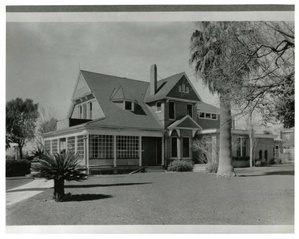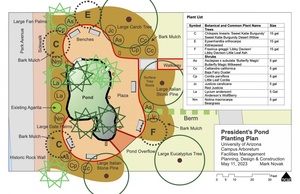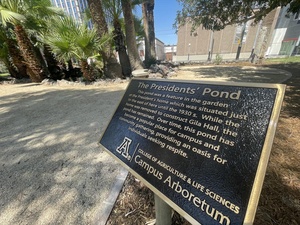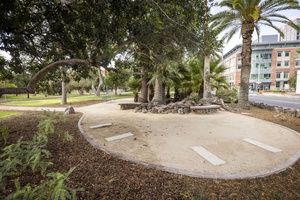What is the Presidents' Pond?
The Presidents' Pond, also known colloquially as the Turtle Pond, is a water fixture on the University of Arizona main campus. Though not hidden by design, the pond is tucked away in a corner of campus that is less frequently visited. The small pond sits on the southeast corner of Park Ave. and 2nd Street, adjacent to the Gila Residence Hall to its east. This water feature was built to mimic the displays of lily ponds In Victorian-style constructions, which were popular at the time of its creation in the late 19th century4. The area surrounding the pond is furnished with palm trees and other lush greenery that is meant to evoke the image of an oasis in the desert. In addition to the greenery surrounding the pond there are koi fish and box turtles in the pond, with blue herons occasionally being sighted in and around it as well. The pond itself is a relatively small portion of the greenery encompassing the west end of campus, also called the Park Avenue Greenbelt, but is notable in that it is one of the only major water features around campus. Another nearby water feature is the fountain outside the University’s Old Main building.
The Presidents' Residence and the Historic District
It is believed that the President’s Pond was part of the backyard of the original residence of the first president of the University of Arizona, hence its name. The residence was a Queen Anne-style home sitting on the UArizona campus, and was torn down to make way for Gila Residence Hall, which still sits on the northeast corner of the Historic District (along James E. Rogers Way and adjacent to the location of the pond)3. The original structure that served as the university president’s home was used from 1897 until its demolition in 1937 when Gila Hall took its place, with the pond being constructed in 1933 while the president's home was still in use5.
 The old President's Residence as pictured before its demolition in 1937 to make way for Gila Hall.
The old President's Residence as pictured before its demolition in 1937 to make way for Gila Hall.
The pond – along with other buildings, infrastructure, and greenery making up the Historic District – comprise a 33-acre area that is designed to recognize and maintain historic features that are a hallmark of the time period of the University’s founding. This picturesque region is recognized on the National Register of Historic Places and active efforts are made by the University to maintain its appearance alongside practical functionality, with greenery and shading intended to cool down walkways and other areas around the Historic District4.
Preservation and Renovation of the Pond
In 2005, funding from the Getty Foundation Campus Heritage Grant Program enabled improvements throughout campus to enable the continuation and expansion of preservation efforts to historic parts of the UArizona campus5. On the UArizona campus, preservation efforts include maintenance of trees, green spaces, and enhancement of the Campus Arboretum system to ensure better understanding and learning throughout these historic areas. The Campus Arboretum is composed of a series of plaques that indicate both botanical and common names for all of the botany around campus. The plants in the Arboretum are an assortment of different species, both native and non-native, that are monitored and maintained to determine their viability in Tucson’s desert climate1. In terms of the pond specifically, money for the project has come from fundraising and donations as a result of the lack of specific allocations in the existing grants for campus heritage.
 A diagram picturing the intended renovations and improvements to the pond, spearheaded by landscape architect Mark Novak.
A diagram picturing the intended renovations and improvements to the pond, spearheaded by landscape architect Mark Novak.
 The commemorative plaque for the pond, completed in summer of 2023.
The commemorative plaque for the pond, completed in summer of 2023.
The major renovations for the pond have been completed, with the final step being the installation of the commemorative informational plaque over the summer of 2023. The improvements include a spillway, improved greenery, decomposed granite brick walkways, and benches along the pond’s exterior. These additions serve the primary purpose of maintaining the appearance and status of the Historic District on campus, while the granite bricks and spillway also serve to mitigate potential consequences from overflows or excess water that could damage the area around the pond. Though these renovations are completed, there are still opportunities for potential donors to contribute. Commemorative inscribed bricks can be purchased, and will be used along a walkway leading to the pond from the service road adjacent to Gila Hall to the east. Another method of contribution is the sponsoring of iron benches to be placed around the plaza surrounding the pond and the Park Ave. Greenbelt area2.
Ironically, despite its colloquial name of the Turtle Pond, the turtles that reside within it are one of the few aspects not maintained by campus groundskeepers and the Campus Arboretum1. This is likely due to the fact that they were not intentionally introduced, and are abandoned pets that came to reside in the pond after its creation by the University.
 Spaces allocated for commemorative benches, which can be purchased by donors.
Spaces allocated for commemorative benches, which can be purchased by donors.
Nearby Landmarks and Structures
The nearest public transportation stops are the 2nd Street/Olive Ave. Sun Link stop (northeast of the pond) and the Marshall West (CatTran Green) and Marshall East (CatTran Purple). The University/Tyndall Ave. Sun Link stop is also nearby to the west.
There are many university dorms and residence halls nearby, including:
- Gila Hall
- Coconino Dorm
- Manzanita-Mohave Hall
- Maricopa Hall
- Yuma Hall
Other notable locations nearby include:
- University of Arizona Old Main
- Arizona History Museum (west, across Park Ave.)
- Arizona State Museum (south, along University Blvd.)
- Slonaker House (north)
- Centennial Hall
- University Boulevard (shopping and entertainment)
References
1. Ground, Jason. The 1933 campus pond known for its turtle residents has undergone a renovation, July 17, 2023. https://uaatwork.arizona.edu/lqp/1933-campus-pond-known-its-turtle-residents-has-undergone-renovation.
2. “Outreach - Presidents’ Pond Improvements.” Campus Arboretum. Accessed February 25, 2024. https://arboretum.arizona.edu/outreach-presidents-pond-improvements.
3. “The Pond.” Campus Arboretum. Accessed February 25, 2024. https://arboretum.arizona.edu/pond.
4. “President’s Pond - An Oasis from Urban Life on the Edge of Campus.” Campus Arboretum. Accessed February 25, 2024. https://arboretum.arizona.edu/presidents-pond.
5. “The President’s Pond, Past and Present.” University of Arizona News, July 21, 2023. https://news.arizona.edu/photos/presidents-pond-past-and-present.


